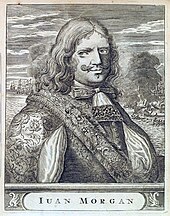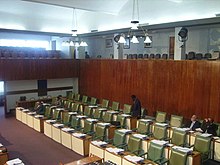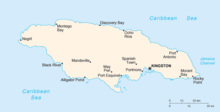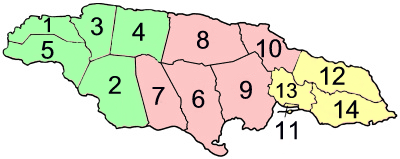Jamaica
Coordinates: 18°10′57″N 77°19′18″W / 18.1823878°N 77.3217773°W
| Commonwealth of Jamaica | ||||||
|---|---|---|---|---|---|---|
|
||||||
| Motto: "Out of Many, One People" | ||||||
| Anthem: "Jamaica, Land We Love" Royal anthem: "God Save the Queen" |
||||||
| Capital (and largest city) |
Kingston 17°59′N 76°48′W / 17.983°N 76.8°W |
|||||
| Official language(s) | English | |||||
| Demonym | Jamaican | |||||
| Government | Parliamentary democracy and Constitutional monarchy | |||||
| - | Monarch | Elizabeth II | ||||
| - | Governor-General | Patrick Allen | ||||
| - | Prime Minister | Portia Simpson-Miller | ||||
| Independence | ||||||
| - | from the United Kingdom | 6 August 1962 | ||||
| Area | ||||||
| - | Total | 10,991 km2 (166th) 4,244 sq mi |
||||
| - | Water (%) | 1.5 | ||||
| Population | ||||||
| - | July 2010 estimate | 2,847,232[1] (133rd) | ||||
| - | Density | 252/km2 (49th) 656/sq mi |
||||
| GDP (PPP) | 2010 estimate | |||||
| - | Total | $23.716 billion[2] | ||||
| - | Per capita | $8,727[2] | ||||
| GDP (nominal) | 2010 estimate | |||||
| - | Total | $13.694 billion[2] | ||||
| - | Per capita | $5,039[2] | ||||
| Gini (2000) | 37.9 (medium) | |||||
| HDI (2010) | ||||||
| Currency | Jamaican dollar (JMD) |
|||||
| Time zone | (UTC-5) | |||||
| Drives on the | left | |||||
| ISO 3166 code | JM | |||||
| Internet TLD | .jm | |||||
| Calling code | +1-876 | |||||
Jamaica ![]() i/dʒəˈmeɪkə/ (officially the Commonwealth of Jamaica) is an island nation of the Greater Antilles, 234 kilometres (145 mi) in length, up to 80 kilometres (50 mi) in width and 10,990 square kilometres (4,243 sq mi) in area. It is situated in the Caribbean Sea, about 145 kilometres (90 mi) south of Cuba, and 191 kilometres (119 mi) west of Hispaniola, the island harbouring the nation-states of Haiti and the Dominican Republic. Its indigenous Arawakan-speaking Taíno inhabitants named the island Xaymaca, meaning the "Land of Wood and Water", or the "Land of Springs".[4]
i/dʒəˈmeɪkə/ (officially the Commonwealth of Jamaica) is an island nation of the Greater Antilles, 234 kilometres (145 mi) in length, up to 80 kilometres (50 mi) in width and 10,990 square kilometres (4,243 sq mi) in area. It is situated in the Caribbean Sea, about 145 kilometres (90 mi) south of Cuba, and 191 kilometres (119 mi) west of Hispaniola, the island harbouring the nation-states of Haiti and the Dominican Republic. Its indigenous Arawakan-speaking Taíno inhabitants named the island Xaymaca, meaning the "Land of Wood and Water", or the "Land of Springs".[4]
Once a Spanish possession known as Santiago, in 1655 it became an English, and later a British, colony, known as "Jamaica". It achieved full independence on August 6, 1962.[5] With 2.8 million people, it is the third most populous anglophone country in the Americas, after the United States and Canada. It remains a Commonwealth realm in concert with the Monarchy of Jamaica holding ultimate executive power, where Queen Elizabeth II is the current head of state and Queen of Jamaica.[6][7][8] Kingston is the country's largest city and the capital.[9]
Contents[hide] |
History
Prehistory
The Arawak and Taino indigenous people, originating in South America, settled on the island between 4000 and 1000 BC.[10] When Christopher Columbus arrived in 1494, there were over 200 villages ruled by caciques (chiefs of villages). The south coast of Jamaica was the most populated, especially around the area now known as Old Harbour.[10] The Tainos were still inhabiting Jamaica when the English took control of the island.[10] The Jamaican National Heritage Trust is attempting to locate and document any evidence of the Taino/Arawaks.[11]
Spanish rule
Christopher Columbus claimed Jamaica for Spain after landing there in 1494 and his probable landing point was Dry Harbour, now called Discovery Bay.[12] There is some debate as to whether he landed in St. Ann's Bay or in Discovery Bay. St. Ann's Bay was the "Saint Gloria" of Columbus who first sighted Jamaica at this point. One mile west of St. Ann's Bay is the site of the first Spanish settlement on the island, Sevilla, which was established in 1509 and abandoned around 1524 because it was deemed unhealthy.[13] The capital was moved to Spanish Town, then called "St. Jago de la Vega", around 1534 and is located in present day St. Catherine.[14]
British rule
Out of all the British colonies in the Caribbean, Spanish Town has the oldest cathedral.[14] The Spanish were forcibly evicted by the English at Ocho Rios in St. Ann. In 1655 the English, led by William Penn and General Robert Venables, took over the last Spanish fort in Jamaica.[15] The name of Montego Bay, the capital of the parish of St. James, was derived from the Spanish name manteca bahía (or Bay of Lard) for the large quantity of boar used for the lard-making industry.[16]

In 1660, the population of Jamaica was about 4,500 whites and 1,500 blacks,[18] but as early as the 1670s, blacks would form a majority of the population.[19]
When the English captured Jamaica in 1655 the Spanish colonists fled after freeing their slaves.[15] The slaves fled into the mountains, joining those who had previously escaped from the Spanish to live with the Taínos.[20] These runaway slaves, who became known as the Jamaican Maroons, fought the British during the 18th century.[20] The name is still used today for their modern descendants. During the long years of slavery Maroons established free communities in the mountainous interior of Jamaica, maintaining their freedom and independence for generations.
During its first 200 years of British rule, Jamaica became one of the world's leading sugar-exporting, slave-dependent nations, producing more than 77,000 tons of sugar annually between 1820 and 1824. After the abolition of the slave trade in 1807,[21] the British imported Indian and Chinese workers as indentured servants to supplement the labour pool. Descendants of indentured servants of Indian and Chinese origin continue to reside in Jamaica today.
By the beginning of the 19th century, Jamaica's heavy reliance on slavery resulted in blacks outnumbering whites by a ratio of almost 20 to 1. Even though England had outlawed the importation of slaves, some were still smuggled into the colonies. The British government drew up laws regimenting the abolition of slavery, but they also included instructions for the improvement of the slaves' way of life. These instructions included a ban of the use of whips in the field, a ban on the flogging of women, notification that slaves were to be allowed religious instruction, a requirement that slaves be given an extra free day during the week when they could sell their produce as well as a ban on Sunday markets.
In Jamaica these measures were resisted by the House of Assembly. The Assembly claimed that the slaves were content and objected to Parliament's interference in island affairs, although many slave owners feared possible revolts. Following a series of rebellions and changing attitudes in Great Britain, the nation formally abolished slavery in 1834, with full emancipation from chattel slavery declared in 1838. The population in 1834 was 371,070 of whom 15,000 were white, 5,000 free black, 40,000 ‘coloured’ or mixed race, and 311,070 slaves.[18]
In the 19th century, the British established a number of botanical gardens. These included the Castleton Garden, set up in 1862 to replace the Bath Garden (created in 1779) which was subject to flooding. Bath Garden was the site for planting breadfruit brought to Jamaica from the Pacific by Captain William Bligh. Other gardens were the Cinchona Plantation founded in 1868 and the Hope Garden founded in 1874. In 1872, Kingston became the island's capital.
In 1945, Sir Horace Hector Hearne became Chief Justice and Keeper of the Records in Jamaica. He headed the Supreme Court, Kingston between 1945 and 1950/1951. He then moved to Kenya where he was appointed Chief Justice.
Independence
Jamaica slowly gained increasing independence from the United Kingdom and in 1958, it became a province in the Federation of the West Indies, a federation among the British West Indies. Jamaica attained full independence by leaving the federation in 1962.
Strong economic growth, averaging approximately 6% per annum, marked the first ten years of independence under conservative governments which were led successively by Prime Ministers Alexander Bustamante, Donald Sangster and Hugh Shearer. The growth was fuelled by strong investments in bauxite/alumina, tourism, manufacturing industry and, to a lesser extent, the agricultural sector.
The optimism of the first decade was accompanied by a growing sense of inequality, and a sense that the benefits of growth were not being experienced by the urban poor. This, combined with the effects of a slowdown in the global economy in 1970, prompted the electorate to change government, electing the PNP (People's National Party) in 1972. Despite efforts to create more socially equitable policies in education and health, Jamaica continued to lag economically, with its gross national product having fallen in 1980 to some 25% below the 1972 level. Rising foreign and local debt, accompanied by large fiscal deficits, resulted in the invitation of the International Monetary Fund (IMF) financing from the United States and others, and the imposition of IMF austerity measures (with a greater than 25% interest rate per year).
Economic deterioration continued into the mid-1980s, exacerbated by a number of factors; the first and third largest alumina producers, Alpart and Alcoa closed, and there was a significant reduction in production by the second largest producer, Alcan. In addition, tourism decreased and Reynolds Jamaica Mines, Ltd. left the Jamaican industry.
Government and politics

Jamaica is a parliamentary democracy and constitutional monarchy, with Queen Elizabeth II serving as the Jamaican monarch.[22] However, as Elizabeth II is shared as head of state of fifteen other countries and resides mostly in the United Kingdom, she is thus often represented as Queen of Jamaica in Jamaica and abroad by the Governor-General of Jamaica.[23] The governor-general is nominated by the Prime Minister of Jamaica and the entire Cabinet and appointed by the monarch. All the members of the Cabinet are appointed by the governor-general on the advice of the prime minister. The monarch and the governor-general serve largely ceremonial roles, apart from their potent reserve power to dismiss the prime minister or parliament.
Jamaica's current constitution was drafted in 1962 by a bipartisan joint committee of the Jamaican legislature. It came into force with the Jamaica Independence Act, 1962 of the United Kingdom parliament, which gave Jamaica independence.
The Parliament of Jamaica is bicameral, consisting of the House of Representatives (Lower House) and the Senate (Upper House). Members of the House (known as Members of Parliament or MPs) are directly elected, and the member of the House of Representatives who, in the governor-general's best judgement, is best able to command the confidence of a majority of the members of that House, is appointed by the governor-general to be the prime minister. Senators are nominated jointly by the prime minister and the parliamentary Leader of the Opposition and are then appointed by the governor-general.
In February 2006, Portia Simpson-Miller was elected by delegates of the ruling People's National Party (PNP) to replace P. J. Patterson as president of the party. At the end of March 2006, when Patterson demitted office, Simpson-Miller became the first female Prime Minister of Jamaica. Former Prime Minister Patterson had held office since the 1992 resignation of Michael Manley. Patterson was re-elected three times, the last being in 2002.
On 3 September 2007, Bruce Golding of the Jamaica Labour Party was voted in as Prime Minister-Designate after achieving a 33 – 27 seat victory over Portia Simpson-Miller and the PNP in the 2007 Jamaican general election. Portia Simpson-Miller conceded defeat on 5 September 2007.[24] On 11 September 2007, after being sworn in by Governor-General Kenneth Hall, The Hon. Bruce Golding assumed office as Prime Minister of Jamaica.
Jamaica has traditionally had a two-party system, with power often alternating between the People's National Party and Jamaica Labour Party (JLP). Over the past decade a new political party called the National Democratic Movement (NDM) emerged in an attempt to challenge the two-party system, though it has become largely irrelevant in this system, as it garnered only 540 votes of the over 800,000 votes cast in the 3 September elections. Jamaica is a full and participating member of the Caribbean Community (CARICOM).
Parishes
Jamaica is divided into 14 parishes, which are grouped into three historic counties that have no administrative relevance.
| Cornwall County | Capital | km2 | Middlesex County | Capital | km2 | Surrey County | Capital | km2 | |||
| 1 | Hanover | Lucea | 450 | 6 | Clarendon | May Pen | 1,196 | 11 | Kingston | Kingston | 25 |
| 2 | Saint Elizabeth | Black River | 1,212 | 7 | Manchester | Mandeville | 830 | 12 | Portland | Port Antonio | 814 |
| 3 | Saint James | Montego Bay | 595 | 8 | Saint Ann | St. Ann's Bay | 1,213 | 13 | Saint Andrew | Half Way Tree | 453 |
| 4 | Trelawny | Falmouth | 875 | 9 | Saint Catherine | Spanish Town | 1,192 | 14 | Saint Thomas | Morant Bay | 743 |
| 5 | Westmoreland | Savanna-la-Mar | 807 | 10 | Saint Mary | Port Maria | 611 | ||||
Military
The Jamaica Defence Force (JDF) is the small but professional military force of Jamaica. The JDF is based on the British military model with organisation, training, weapons and traditions closely aligned with Commonwealth realms. Once chosen, officer candidates are sent to one of several British or Canadian basic officer courses depending on which arm of service they are selected for. Enlisted soldiers are given basic training at JDF Training Depot, Newcastle or Up Park Camp, both in St. Andrew. As with the British model, NCOs are given several levels of professional training as they rise up the ranks. Additional military schools are available for speciality training in Canada, the United States and the United Kingdom.
The JDF is directly descended from the British West India Regiment formed during the colonial era.[25] The West India Regiment was used extensively by the British Empire in policing the empire from 1795 to 1926. Other units in the JDF heritage include the early colonial Jamaica Militia, the Kingston Infantry Volunteers of WWI and reorganised into the Jamaican Infantry Volunteers in World War II. The West Indies Regiment was reformed in 1958 as part of the West Indies Federation, after dissolution of the Federation the JDF was established.
The Jamaica Defence Force (JDF) comprises an infantry Regiment and Reserve Corps, an Air Wing, a Coast Guard fleet and a supporting Engineering Unit.[26] The infantry regiment contains the 1st, 2nd and 3rd (National Reserve) battalions. The JDF Air Wing is divided into three flight units, a training unit, a support unit and the JDF Air Wing (National Reserve). The Coast Guard is divided between seagoing crews and support crews who conduct maritime safety and maritime law enforcement as well as defence-related operations.[27] The role of the support battalion is to provide support to boost numbers in combat and issue competency training in order to allow for the readiness of the force.[28] The 1st Engineer Regiment was formed due to an increased demand for military engineers and their role is to provide engineering services whenever and wherever they are needed.[29] The Headquarters JDF contains the JDF Commander, Command Staff as well as Intelligence, Judge Advocate office, Administrative and Procurement sections.[30]
In recent years the JDF has been called on to assist the nation's police, the Jamaica Constabulary Force (JCF), in fighting drug smuggling and a rising crime rate which includes one of the highest murder rates in the world. JDF units actively conduct armed patrols with the JCF in high-crime areas and known gang neighbourhoods. There has been vocal controversy as well as support of this JDF role. In early 2005, an Opposition leader, Edward Seaga, called for the merger of the JDF and JCF. This has not garnered support in either organisa








